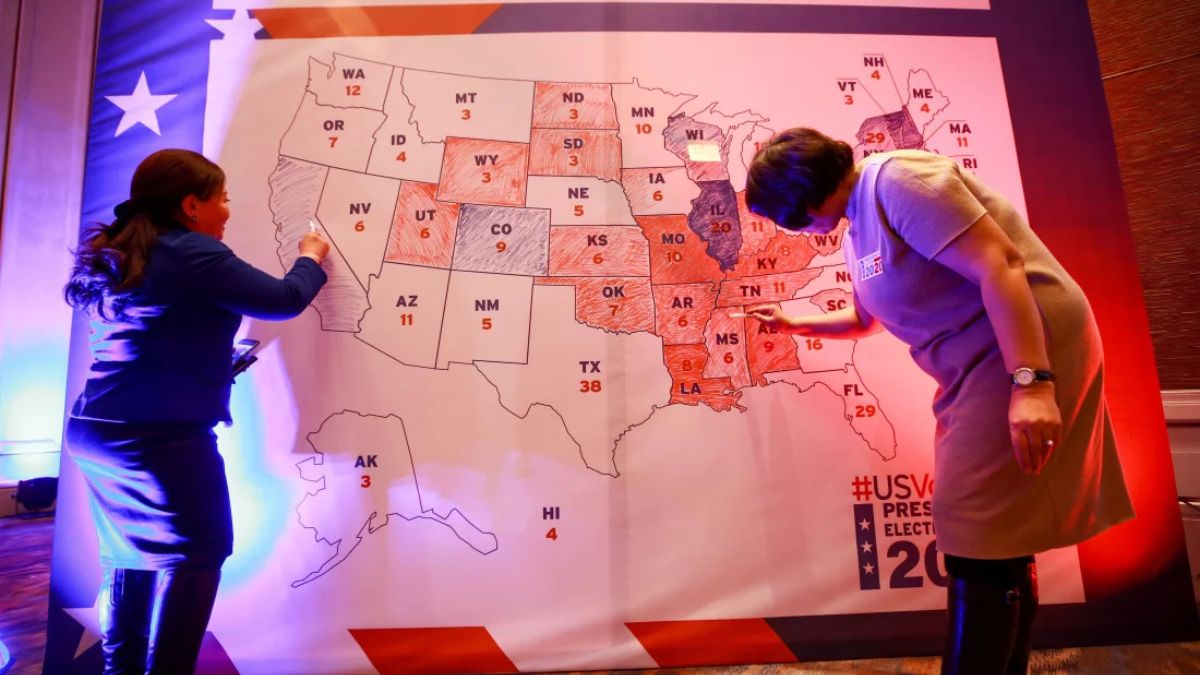The terms “red mirage” and “blue shift” describe how vote counting can create the appearance of changing leads in US elections.
This dynamic, which has played out in recent years, especially in the 2020 election, arises from the different voting methods favoured by Republican and Democratic voters.
Early Election Day results may initially lean red (Republican) or blue (Democratic) depending on which votes are counted first.
What is the Red mirage and the Blue shift?
The “red mirage” refers to an early, often temporary, lead for Republican candidates that appears on election night as in-person votes, typically favouring Republicans, are counted first.
As mail-in and absentee ballots are added — often in the days following the election — a “blue shift” might emerge, showing a surge for Democratic candidates.
According to a study by data firm Hawkfish in 2020, funded by former NYC Mayor Michael Bloomberg, this effect was anticipated to show Trump with an early lead on Election Day, with Biden gradually overtaking as mail ballots were counted.
Edward Foley, an election law expert at Ohio State University, first identified this “blue shift” in a 2019 study. In examining past elections, he found that the Democratic candidate gained votes post-Election Day in every presidential election since 2000.
He found that Democrats received at least 22,000 additional votes post-election, often from mail-in and provisional ballots, which traditionally skew Democratic.
This phenomenon has been compounded by reforms following the 2000 election, which made it easier for voters with registration issues to cast provisional ballots. Often, these ballots come from groups that lean Democratic, including low-income voters and students.
Why do vote counts in the US take time?
Vote totals are often delayed by several factors, especially in urban areas where Democratic votes dominate. For instance, in the 2016 election, Hillary Clinton was still behind when she conceded, despite ultimately winning the popular vote as late ballots were counted.
In the 2020 election, US President Joe Biden gained ground similarly: an MIT study found that Biden-leaning counties reported results slower than Trump-supporting counties. This “blue shift” became clearer post-election night, increasing Biden’s lead by nearly one point in the days following the election.
Also Read: Why does the US still uses paper ballots for its polls?
For 2024, experts anticipate that the “blue shift” could be smaller due to fewer absentee ballots compared to 2020 and increased early voting among Republicans. However, state regulations, population density, and the counting methods of each state will continue to shape how and when results become available.
What states may showcase cases of Red or Blue mirages?
Red mirage states in the US
Wisconsin: Mail-in ballots cannot be processed until Election Day, which may delay results from larger Democratic areas like Milwaukee, leading to an early red mirage.
Michigan: Although local officials can now process mail ballots earlier than in 2020, Protect Democracy predicts a slight red mirage in smaller counties.
Nevada: Heavily populated Clark County may count mail ballots slower, potentially causing a red mirage followed by a blue shift.
Blue mirage states
Georgia: Counties have been allowed to process mail ballots ahead of time, with most results expected shortly after polls close. Early results may show a Democratic lead that could fade as in-person votes are added.
North Carolina: Mail-in ballots are processed first, which could create an initial blue mirage.
Arizona: Early mail ballots are reported first, followed by in-person ballots, leading to a likely blue mirage that could narrow as more GOP votes come in.
Pennsylvania’s potential for both mirages
Pennsylvania may see both a blue and red mirage. Early mail-in ballots, reported first, could show a Democratic advantage, while in-person Election Day votes could swing the lead back to Republicans.
Counting all ballots may extend days past Election Day, as was the case in 2020.
Have their been any controversies regarding the phenomena?
Former US President Trump capitalised on the red mirage in 2020, declaring victory prematurely on election night and casting doubts on mail-in votes.
“We want all voting to stop… we don’t want them to find any ballots at 4 o’clock in the morning and add them to the list,” he stated.
The election was only called for Biden days later, on November 7, after decisive wins in Pennsylvania, with additional states like Georgia and North Carolina confirming results on November 19 and November 13, respectively.
Trump also cast doubt on the 2018 midterms, alleging without evidence that the narrowing margins for Republican candidates Rick Scott and Ron DeSantis were due to fraudulent ballots.
Ahead of the 2024 election, Trump has once again suggested potential election fraud, citing cases in Lancaster County where about 60 per cent of voter registration applications were flagged as fraudulent.
This year, both Republicans and Democrats are pushing for timely counts and transparency. Georgia Secretary of State Brad Raffensperger, a Republican, has expressed confidence, telling CBS that most ballots will be counted by 8 pm on Election Day, barring any delays from overseas ballots.
Similarly, speaking to NPR, Pennsylvania’s top elections official Al Schmidt encourages voters to “trust the system,” stating the importance of counting each ballot thoroughly.
Will results be delayed in the 2024 US elections?
The length of time needed to determine a winner remains uncertain. In 2020, the post-election period became a window of vulnerability, with misinformation spreading about delayed results.
In response, many states have refined their counting processes. For example, Georgia and Michigan have updated their rules to allow earlier processing of mail ballots, which may result in faster counts. However, Pennsylvania and Wisconsin still prohibit processing before Election Day, which could prolong the counting period.
It’s worth remembering that certification deadlines allow all states until December 11 to finalise their counts, recounts, and dispute resolutions, if necessary.
Michigan Secretary of State Jocelyn Benson told CBS, “We will always prioritise accuracy and security over efficiency.”
With inputs from agencies
)